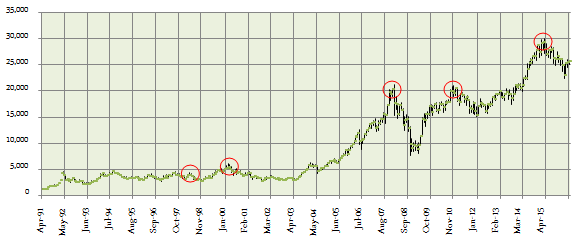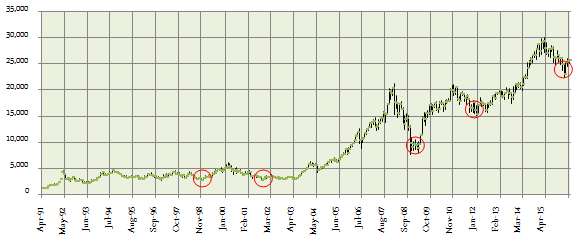Bull and Bear Market Investing: Part 1

Making money in stock markets, from conceptual viewpoint, is quite easy; you buy low and sell high. In bull markets prices are high and in bear markets prices are low. Therefore, ideally, you should be selling in bull markets and buying in bear markets. But retail investors tend to do exactly the opposite in stock markets. Market observers and financial advisors attribute this investment behaviour to herd mentality, but to be fair to retail investors, will the average retail investor even know, whether the market is in a bull phase or a bear phase, especially around points of inflexions?
How will the average retail investor distinguish between a bull market correction and a bear market, or between a bear market rally and a bull market? Finally, how will investors know when the share prices are low enough or when the prices are high enough? We have observed that, even the most experienced and astute market experts fail to correctly call a market top or bottom. Also, very confusing for investors, are the conflicting views of different experts and analysts on each of these questions.
We, in Advisorkhoj, are of the opinion that, there is no need for retail investors to find answers to any of the above questions. In this two part post, we will analyze the results of investing in both bull and bear markets, both with respect to the timing and tenure of investments. We expect that, after going through our blog, the readers will be able to form simple investment strategies for themselves, which will give them good results in all market conditions. Let us clarify at the outset, that this blog post is meant for investors only and not for traders.
Sensex over the last 25 years
Over the last 25 years since April 1991, the Sensex rose from 1,235 to 25,600 at a compounded annual growth rate of nearly 13%. Please note that, we have not factored in dividends and if we did, the returns would have been even higher. No asset class in India would have matched the returns of equities over the last 25 year period. The chart below plots the monthly closing values of the Sensex for the last 25 years, from April 1991 onwards.

Source: Bombay Stock Exchange
You can see that from the peak of 1992, the stock market remain depressed for a number of years. This was because the bull market in the early 90s was distorted by the Harshad Mehta scam. Therefore, let us ignore the Sensex values in the early 90s and examine the above chart from the mid nineties onwards.
You can see that in the chart above that, there were 5 major bull market peaks, shown in the red circles (in the chart):-
- April 1998 – Sensex at around 4,000
- February 2000 – Sensex at around 5,450
- January 2008 – Sensex at around 20,300
- March 2011 – Sensex at around 19,500
- March 2015 – Sensex at around 30,000
Investing at bull market tops
Readers would agree with us that bull market peaks are the worst times to invest. Let us see how much loss you would have made after 1 year, if you invested at the peak of the bull markets.

Source: Bombay Stock Exchange, Advisorkhoj analysis
Obviously the quantum of loss would depend on the severity of the bear market. The financial crisis of 2008 resulted in the worst bear market in 80 years. The bear market of 2015 – 2016, by comparison was much milder. Nevertheless, whether the investor makes a 10% loss or a 50% loss, it always hurts to make a loss. But what if, the investor has a longer investment horizon. Readers who regularly follow our blog know that, market movements caused volatility, which though stressful for the investor, do not result in a loss, unless the investor panics and sells. We believe that, investors should be concerned with losses and not volatility. The table below shows the returns for investors over different investment horizons, when they invested at the bull market peaks.

Source: Bombay Stock Exchange, Advisorkhoj analysis
The table above shows that, if you can hold your investment for more than 3 years you can reverse your losses and make a profit. Mind you, we are discussing the worst case scenarios here, i.e. investments made at bull market peaks (the worst time to invest). Readers may be a little confused about returns over different tenures for investment made in April 1998. Let us go back to the period from 1998 to 2003. While, 2008 has undoubtedly been and hopefully will be, the worst financial crisis of our lifetime, the period from 1998 to 2003 was also extremely challenging for the markets. From 1998 to 2003, the financial markets were rocked by a number of crises in quick succession, one after another. In 1998 we had the Asian currency crisis, which was soon followed by the Russian currency crisis, then the Ketan Parekh scam in Indian stock market, then the dotcom bubble burst, then 9/11 terrorist strikes in the US followed by Iraq war and finally recession in the US and other major economies.
However, the 1998 to 2003 market weakness is probably by now a faint memory in the minds of investors, even for those who were active in that period, because from 2003 to 2008 we had a phenomenal bull market run, when the Sensex rose from 3,000 to over 20,000 in just 5 years. Bear markets do not last forever; bull markets inevitably follow bear markets. While equities can have sharp downturns, the bounce back rallies are usually equally fierce (please read our post, Making sense of volatility in the equity market: A Historical perspective). Retail investors should not worry about the timing the market, they simply need to have a sufficiently long investment horizon, so that they are able to outlast the downturn in the market and then catch the tailwind of bull-market momentum.
Investing at bear market bottoms
We know that bear market bottoms are the best times to invest, because you are buying when the price is lowest. Let us now revisit the Sensex monthly chart over the last 25 years.

Source: Bombay Stock Exchange
You can see that in the chart above that, there were 5 major bear market bottoms, shown in the red circles (in the chart):-
- November 1998 – Sensex at around 2,810 a decline of around 39% from the previous top
- September 2001 – Sensex at around 2,811 a decline of around 34% from the previous top
- October 2008 – Sensex at around 8,500, a decline of around 60% from the previous top
- December 2011 – Sensex at around 15,380 a decline of around 28% from previous top
- March 2016 – Sensex at around 27,800 a decline of around 20% from previous top
Let us now see how much profit you would have made after 1 year, if you invested at the bottom of the bear markets.

Source: Bombay Stock Exchange, Advisorkhoj analysis
You can see that, the returns are phenomenal when you invest at the bear market bottom. The only exception was 2001 bear market, when the returns though positive were modest for reasons discussed above; but otherwise the returns were quite outstanding. Even if you had invested in the Sensex at the end of February and early March this year (2016) when the market was at its bottom, your returns in just about two and half months would have been around 15%. While the benefits of investing in bear markets are fairly obvious from a conceptual standpoint, from a psychological viewpoint, investors are scared to invest in bear markets. We wanted to share the data in the table above with you, just to give you a sense of the returns you can get by investing in bear markets.
At the beginning of this post, we had said that, it is impossible for even market experts, let alone retail investors, to catch the market bottom. However, even if you were to invest 10 – 15% above the market bottom in bear markets, you could still make decent profits in a fairly short time, once the market recovered. But if you wait for markets to recover before investing, you can end up waiting for a long time. Many investors who pulled out of equities in 2008, returned to equities only in 2014, when the market was 70% higher. As discussed, in our post, Making sense of volatility in the equity market: A Historical perspective, bear markets do not last for a very long time. The lengths of bull markets are invariably much more than that of bear markets; that is why the Sensex grew more than 20 times in the last 25 years.
Conclusion
In the past we have observed that many retail investors jumped onto the equity bandwagon in bull markets and pull out of equities in bear markets. In this blog post, we have tried to explain, why timing the market does not really matter, if you have a sufficiently long investment horizon. We discussed the worst case scenario of equity investing and saw that you can recover your losses and make profits over a sufficiently long investment horizon. Bear market phases are the periods, where instead of redeeming your equity mutual funds or stopping your systematic investment plans (SIPs), you should look to tactically add equities to your asset allocation, either through lump sum investments at big corrections or SIPs. In 2015, despite the sharp correction in equity prices, we saw incremental retail flows into equity through mutual funds. This is in sharp contrast to what happened in 2008 and shows the growing maturity of the Indian retail investor. In the next part of this post, we will discuss some simple investment strategies that you can put to practise in bull and bear markets.
All the data/graph/information contained in this document is compiled from third party sources. Whilst Mirae Asset Global Investments (India) Private Limited has to the best of its endeavor ensured that such information is accurate, complete and up-to-date, and has taken care in accurately reproducing the information, it shall have no responsibility or liability whatsoever for the accuracy of such information or any use or reliance thereof. This document shall not be deemed to constitute any offer to sell the schemes of Mirae Asset Mutual Fund.
MUTUAL FUND INVESTMENTS ARE SUBJECT TO MARKET RISKS, READ ALL SCHEME RELATED DOCUMENTS CAREFULLY
RECOMMENDED READS
Mirae Asset Global Investments is the leading independent asset management firm in Asia. With our unique culture of entrepreneurship, enthusiasm and innovation, we employ our expertise in emerging markets to provide exceptional investments opportunities for our clients.
Quick Links
- Fund Manager Interview - Mr. Neelesh Surana - Chief Investment Officer
- Fund Review - Mirae Asset Emerging Bluechip Fund : Best Midcap Mutual Fund in the last 6 years
- Fund Review - Mirae Asset India Opportunities Fund: One of the best SIP returns in last 8 years
- Fund Manager Interview - Mr. Neelesh Surana - Chief Investment Officer
- Our Articles
- Our Website
- Investor Centre
- Mirae Asset Knowledge Academy
- Knowledge Centre
- Investor Awarness Programs
Follow Mirae Assets MF
More About Mirae Assets MF
POST A QUERY






